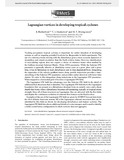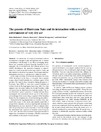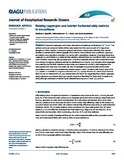Lagrangian vortices in developing tropical cyclones
| dc.contributor.author | Rutherford, B. | |
| dc.contributor.author | Dunkerton, T.J. | |
| dc.contributor.author | Montgomery, M.T. | |
| dc.date.accessioned | 2017-07-12T18:31:56Z | |
| dc.date.available | 2017-07-12T18:31:56Z | |
| dc.date.issued | 2015-10 | |
| dc.identifier.citation | B. Rutherford, T.J. Dunkerton, M.T. Montgomery, "Lagrangian vortices in developing tropical cyclones," Quarterly Journal of the Royal Meteorological Society, v. 141, no.693, (October 2015), Pt. B, pp. 3344-3354. | en_US |
| dc.identifier.uri | https://hdl.handle.net/10945/55214 | |
| dc.description | The article of record as published may be found at http://dx.doi.org/10.1002/qj.2616 | en_US |
| dc.description.abstract | Tracking pre-genesis tropical cyclones is important for earlier detection of developing systems as well as targeting potential locations for dropsondes in field experiments. The use of a reference frame moving with the disturbance gives a more accurate depiction of streamlines and closed circulation than the Earth-relative frame. However, identification of recirculating regions does not require a choice of reference frame when marked by the Galilean invariant Eulerian Okubo– Weiss (OW) parameter. While the Eulerian OW parameter is generally effective at identifying vortex cores at a given place and a given time, it has its limitations in weak disturbances and in time-dependent flows. Integrating the eigenvalue of the velocity gradient tensor along particle trajectories provides a time- smoothing of the Eulerian OW parameter, and provides earlier detection with fewer false alarms. We refer to this integration along trajectories as the Lagrangian OW parameter. When mapped to a horizontal grid it becomes a Lagrangian OW field. The Lagrangian OW field has advantages over the Eulerian OW field in the detail of additional flow structures that it identifies. The Lagrangian OW field shows the Lagrangian boundaries that are present as a disturbance develops from an easterly wave, and a shear sheath that forms when a disturbance becomes self-sustaining, typically at tropical storm strength. Since all of these structures are Lagrangian, they are advected with the flow field, and display the continuous evolution of coherent flow features as the fluid evolves. Examples of the use of the Lagrangian OW field are given for ECMWF forecast data from the 2014 Atlantic hurricane season. All of the Lagrangian coherent structures that can be identified by this field are shown for developing disturbances and mature cyclones. The Lagrangian OW field also shows additional details of vortex mergers, and is used to identify a stable crystal lattice configuration in which vorticity does not aggregate. | en_US |
| dc.description.sponsorship | National Science Foundation | en_US |
| dc.description.sponsorship | NASA | en_US |
| dc.description.sponsorship | Naval Postgraduate School | en_US |
| dc.format.extent | 11 p. | en_US |
| dc.publisher | Royal Meteorological Society | en_US |
| dc.rights | This publication is a work of the U.S. Government as defined in Title 17, United States Code, Section 101. Copyright protection is not available for this work in the United States. | en_US |
| dc.title | Lagrangian vortices in developing tropical cyclones | en_US |
| dc.type | Article | en_US |
| dc.contributor.corporate | Naval Postgraduate School (U.S.) | en_US |
| dc.contributor.department | Meteorology | en_US |
| dc.subject.author | Vortex identification | en_US |
| dc.subject.author | Lagrangian coherent structures | en_US |
| dc.subject.author | Tropical cyclogenesis | en_US |
| dc.description.funder | Grant AGS-1439283 (NSF) | en_US |
| dc.description.funder | Grant AGS-1313948 (NSF) | en_US |
| dc.description.funder | Grant NNG11PK021 (NASA) | en_US |





